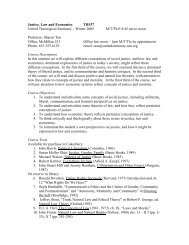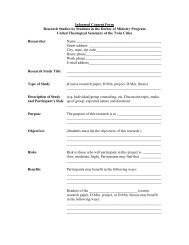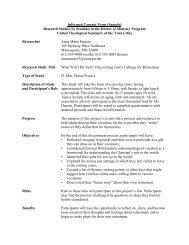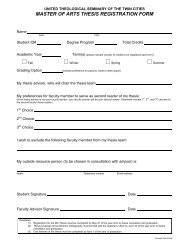CS251/252 "Religious Leadership, Organization, Administration and ...
CS251/252 "Religious Leadership, Organization, Administration and ...
CS251/252 "Religious Leadership, Organization, Administration and ...
Create successful ePaper yourself
Turn your PDF publications into a flip-book with our unique Google optimized e-Paper software.
2<br />
e) This last matter of vocational discernment evokes a final, general goal: to be able to engage in<br />
theological reflection about oneself <strong>and</strong> about the church involved with others in context.<br />
METHODS<br />
The basic method for this course is critical reflection on practice. Such practice includes the social<br />
context as well as our personal experiences in congregations. Particular praxeological methods will vary<br />
with the kind of personal experience or social reality being studied. Much learning will be of an inductive<br />
nature--allowing unforeseen insight to emerge from myriad experiences <strong>and</strong> from the process itself.<br />
Course readings, h<strong>and</strong>outs, lectures <strong>and</strong> consultations with field instructors will provide various resources<br />
for help with our praxeological reflection as practical theologians. Basic methods are especially<br />
introduced during the first weeks of the course. In addition, particular approaches to contextual study are<br />
given in the assignments for each week. Individualized learning is also encouraged in the field contexts,<br />
<strong>and</strong> a worksheet for constructing an individualized learning agenda is provided in the <strong>CS251</strong>/<strong>252</strong> packet.<br />
ADDITIONAL MATERIALS<br />
In addition to this syllabus, there is a packet of materials for <strong>CS251</strong>/<strong>252</strong> including a H<strong>and</strong>book for<br />
<strong>CS251</strong>/<strong>252</strong>. The packet <strong>and</strong> the H<strong>and</strong>book contain: (1) statements of policy; (2) additional explanation<br />
of contextual studies <strong>and</strong> congregational internships, (3) clarification about roles, responsibilities, <strong>and</strong><br />
relationships between intern, field instructor, <strong>Leadership</strong> Advisory Group, <strong>and</strong> the seminary, <strong>and</strong> (4)<br />
worksheets to facilitate the process. The worksheets relate to: (a) the initial process of establishing<br />
learning goals <strong>and</strong> a learning agenda, <strong>and</strong> (b) a process for mid-semester <strong>and</strong> final evaluations. All these<br />
materials are also available on the “<strong>CS251</strong>/CS<strong>252</strong>” link on the Contextual Studies website:<br />
http://mercury.unitedseminary-mn.org/context. In addition, see the UTS Student H<strong>and</strong>book for other<br />
relevant policies, such as that on extensions <strong>and</strong> inclusive language [2007-2008 edition, pp. 42, 108-9]<br />
ASSIGNMENTS<br />
Both reading <strong>and</strong> writing assignments are detailed in the schedule below. For the Fall semester, a<br />
brief written assignment is required each week; in the Spring semester, there will be longer assignments<br />
but fewer in number. Students are advised to stay well ahead in the assigned reading--reading the<br />
material as early in the week as possible (or even in advance of the week concerned). The written<br />
assignments follow from the reading <strong>and</strong> serve to focus attention more concretely on a particular<br />
congregation in context. In most instances, one will need to pursue the week's field work with the reading<br />
<strong>and</strong> written assignments in mind.<br />
SITE VISITS<br />
Once during the year—in either the Fall semester or the Spring semester or even during the Jan.<br />
term—students should arrange for a site visit to their congregations by Trish Greeves or Joe Bush. The<br />
timing of these site visits can vary according to need <strong>and</strong> circumstance. Students are asked to request a<br />
time when a site visit might be most helpful to them. Some students may want to time this site visit early<br />
in the Fall in order to help clarify the process or to facilitate goal-setting. Other students, however, may<br />
want someone from the seminary to be present late in the semester in order to assist with final<br />
evaluations. Still other students may want someone from the seminary to be present at different times in<br />
order to observe an event in ministry, e.g. the student preaching a sermon, etc. These site visits should be<br />
planned as soon as possible, though, even if for the end of semester. Also Trish Greeves <strong>and</strong> Joe Bush are<br />
often not able to find Sundays free if asked just one or two weeks ahead of time. Weekday <strong>and</strong> evening<br />
invitations are encouraged. A typical site visit includes three aspects:<br />
1) A meeting with the <strong>Leadership</strong> Advisory Group;<br />
2) A meeting with the field instructor (sometimes simply included in the LAG meeting);<br />
3) Observation of you as the intern engaged in some form of leadership or ministry.<br />
This meeting is for the intern’s benefit--to facilitate supervision & feedback for the intern in the<br />
ministerial context. Interns should take the initiative in organizing this site visit, setting the agenda <strong>and</strong>







